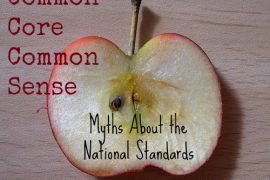These days I’m devouring just about any writing I can find that features the cross section between neurology, sociology and psychology. Daniel Pink’s Drive completely changed my mind and confirmed my suspicions about how motivation actually works. And now The Organized Mind by behavioral neurologist Daniel Levitin has helped me better understand how the brain helps us organize our time, thoughts and things — and how our brains can get in the way.
It’s a big book. And parts of it are very dense, including sections that explain the anatomy of the brain and almost an entire chapter devoted to the probabilities of medical outcomes. But the rest of the book is quite narrative, with funny and relatable examples. This science and geek loved it all.
For me, the takeaways were in productivity and learning. It’s not fair to boil it all down to two categories, but I will. At the same time, I’ll point out how all of this relates to math, with a few quotes from Levitin‘s book.
What the Brain Does Well
Categorization
Turns out the brain is perfectly designed for identifying similarities and differences.
In the last few years, we’ve learned that the formation and maintenance of categories have their roots in known biological processes in the brain. … Theoretically, you should be able to represent uniquely in your brain every known particle in the universe, and have excess capacity left over to organize those particles into finite categories. Your brain is just the tool for the information age.
Where’s the math in that? Everywhere. It could be argued that math is the study of categories. Start with our number system. Positive numbers that are not fractions and decimals fall in the category of whole numbers. Add negative numbers to that group, and you’ve got integers. (And so on.) Or you can group numbers as prime and not prime or even and odd. Graphs of equations can be lines or curves — and some curves are parabolas, while others are circles. See where I’m going with this?
This is all good news. Because the brain is so excellent at forming and maintaining categories, your brain was made for math.
Discovery
But how can we make sure we remember all of these categories?
The last two decades of research on the science of learning have shown conclusively that we remember things better, and longer, if we discover them ourselves rather than being told them explicitly.
This idea has huge implications for math education. For the most part, approaches to teaching math fall in one of two categories (see what I did there?): telling and discovering. Most of us who grew up in the 70s and 80s learned math through the “telling” method. The teacher gave a lecture, demonstrating how to perform a skill, and asking students to practice the steps shown in the lesson. Discovery turns this process on its head, giving students the opportunity to figure things out on their own, even finding new ways to solve problems. When they can discover ideas on their own, students have a much better shot at remembering what they’ve learned.
Of course discovery is messy and difficult, which brings us to ways that our brain gets in the way.
What the Brain Doesn’t Do Well
Frustration
This idea from Levitin blew my mind. Apparently it’s a proven fact that people don’t manage frustration well. It’s why we procrastinate, and that feeling of frustration is rooted in our brains.
The low tolerance for frustration has neural underpinnings. Our limbic system and the parts of the brain that are seeking immediate rewards come into conflict with our prefrontal cortex, which all too well understand the consequences of falling behind. Both regions run on dopamine, but the dopamine has different actions in each. Dopamine in the prefrontal cortex causes us to focus and stay on task; dopamine in the limbic system, along with the brain’s own edogenous opiods, causes us to feel pleasure.
Then we play into this automatic system with two “faulty beliefs: first, that life should be easy and second, that our self-worth is dependent on our success.” So, when the going gets tough, we quit — shoot for an easier option.
Unfortunately, this is just something we need to fight against. And Levitin has some great strategies to offer. At the same time, I felt very validated in my instinct to choose low-hanging fruit, rather than reaching for loftier goals. That also goes for the math student who is immediately frustrated by assignments he can’t understand, and the grownup who always lets someone else split the restaurant tab.
Probability
For years I’ve struggled with my inability to internalize the concepts of probability, so I was really relieved to learn that my brain is wired this way.
Cognitive science has taught us that relying on our gut or intuition often leads to bad decisions, particularly in cases where statistical information is available. Our guts and our brains didn’t evolve to deal with probabilistic thinking.
No wonder I have to work so hard to understand the probability I’ll suffer from a medication’s side effects or even the chance I’ll win in Roulette. Unlike categorizing, my brain isn’t set up to have an intuition about probability. (This isn’t to say that others can’t find calculate probabilities quickly, of course.)
Of course much depends on our understanding of probability, including life-and-death situations, like choosing the right medical treatment. It’s important to think about these things in a clear and focused way. That’s one reason Levitin spends so many pages on something called FourFold tables. (More on those in a later post.)
I encourage you to pick up a copy of The Organized Mind. (No, you can’t borrow mine; I’ve been referring to it over and over since I finished reading!) It’s a great look at how we can maximize the things our brains do well and work against the tricks our brains play on us — to be better organized and productive, while learning and using math.
Photo Credit: dierk schaefer via Compfight cc
Have you read Daniel Levitin’s book? If so, what did you think? Share your comments and questions.









